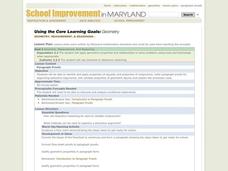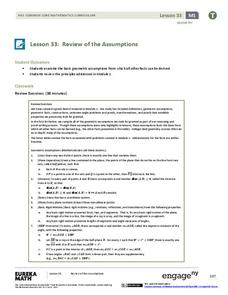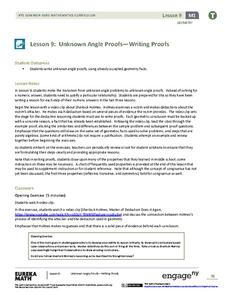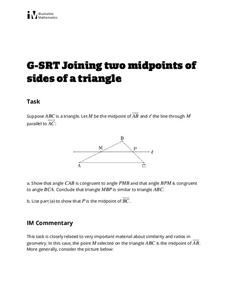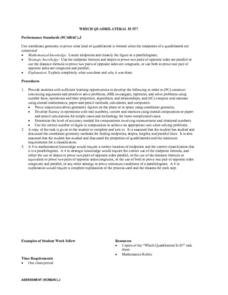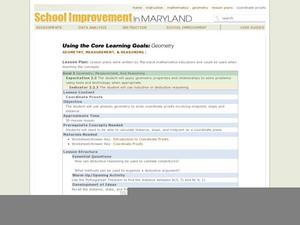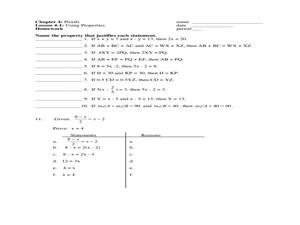Radford University
Parallel Lines Cut by a Transversal
Use the parallel lines to find your way. After first reviewing geometric constructions and the relationships between angles formed by parallel lines and a transversal, young mathematicians write proofs for theorems relating to parallel...
EngageNY
Multiplying Polynomials
There's only one way to multiply, right? Not when it comes to polynomials. Reach each individual by incorporating various representations to multiplying polynomials. This lesson approaches multiplying polynomials from all angles. Build...
EngageNY
Law of Cosines
Build upon the Pythagorean Theorem with the Law of Cosines. The 10th part of a 16-part series introduces the Law of Cosines. Class members use the the geometric representation of the Pythagorean Theorem to develop a proof of the Law of...
Radford University
Parallel Lines Cut By a Transversal
Perhaps planning a city isn't so difficult after all. Scholars first perform geometric constructions and investigate how parallel lines are useful in real-world situations. They then work on a city design project, drawing street maps,...
Curated OER
Preparation and Transition to Two-Column Proofs
Students investigate proofs used to solve geometric problems. In this geometry lesson, students read about the history behind early geometry and learn how to write proofs correctly using two columns. The define terminology valuable to...
Curated OER
Paragraph Proofs
Students explore the concept of paragraph proofs. In this paragraph proofs lesson plan, students make flow charts of the process of getting ready for school. Students convert the flow chart to a paragraph proof. Students use geometric...
EngageNY
Review of the Assumptions (part 1)
What was the property again? Tired of hearing this from your pupils? Use this table to organize properties studied and as a reference tool for individuals. Learners apply each property in the third column of the table to ensure their...
EngageNY
Unknown Angle Proofs—Writing Proofs
What do Sherlock Holmes and geometry have in common? Why, it is a matter of deductive reasoning as the class learns how to justify each step of a problem. Pupils then present a known fact to ensure that their decision is correct.
EngageNY
End-of-Module Assessment Task - Geometry (module 1)
Have you hit a wall when trying to create performance task questions? Several open-ended response questions require a deep level of thinking. Topics include triangle congruence, quadrilaterals, special segments, constructions, and...
Illustrative Mathematics
Joining Two Midpoints of Sides of a Triangle
Without ever using the actual term, this exercise has the learner develop the key properties of the midsegment of a triangle. This task leads the class to discover a proof of similar triangles using the properties of parallel...
EngageNY
Scale Factors
Is it bigger, or is it smaller—or maybe it's the same size? Individuals learn to describe enlargements and reductions and quantify the result. Lesson five in the series connects the creation of a dilated image to the result. Pupils...
EngageNY
Looking More Carefully at Parallel Lines
Can you prove it? Making assumptions in geometry is commonplace. This resource requires mathematicians to prove the parallel line postulate through constructions. Learners construct parallel lines with a 180-degree rotation and then...
Curated OER
The Proof Is in the Picture
Students select a geometric figure and find an example of the figure in their surroundings. They photograph the figure and write a proof to accompany it. They match photos to proofs.
Curated OER
Perfumania
High schoolers identify various geometric shapes. Apply the given formulas to determine the volume of these shapes. Design their own container to conform to specifications provided. Use their knowledge of volume formulas and shapes to...
Mathematics Assessment Project
Square
Don't be a square! Young mathematicians determine the slope and length of a line segment. They then prove whether four given coordinate points form a square.
Cord Online
Pyramids and Cones
Young mathematicians find the surface area and volume of a square pyramid and a cone. In what looks like a typical activity out of a textbook, you'll find an activity where learners find an unknown measurement of a pyramid or...
Rice University
Algebra and Trigonometry
Move on into trigonometry. An informative eBook takes the content of a College Algebra course and adds more relating to trigonometry and trigonometric functions. The content organization allows pupils to build upon their learning by...
Curated OER
Which Quadrilateral Is It?
Young scholars prove conjectures about geometric figures on the plane or in space using coordinate geometry. They develop fluency in operations with real numbers, vectors and matrices using mental computation or paper-and-pencil...
Curated OER
Coordinate Proofs
Students explore the concept of coordinate proofs. In this coordinate proofs lesson, students write coordinate proofs using properties of distance, slope, and midpoint. Students discuss why it is sometimes beneficial to double the...
Curated OER
Using Properties Homework
In this geometry worksheet, 10th graders determine the property of the real number system that justifies each given statement and complete a two column proof in which they justifying the steps for solving an equation. The one page...
Curated OER
Why do Stars Rise in the East?
In this stars rise in the east worksheet, students use geometry to show how the Earth rotates from west to east and why celestial bodies appear to rise in the east and set in the west. Students draw a figure and label given points in...
Curated OER
The Pythagorean Theorem
Young scholars create both a visual and formal proof of the Pythagorean theorem, as well as view four additional geometric demonstrations of the theorem. They construct a square and conjecture the following theorem: The sum of the areas...
Illustrative Mathematics
Points equidistant from two points in the plane
Young geometers apply their deductive reasoning skills and knowledge of proving triangles congruent in a task that asks them to prove if a point lies on the perpendicular bisector of a segment, then it is equidistant from the endpoints...
EngageNY
Applications of the Pythagorean Theorem
Examine the application of the Pythagorean Theorem in problem-solving questions. Pupils apply the theorem to find lengths when given different scenarios. They finish the 17th installment in an 18-part series by applying the theorem...







